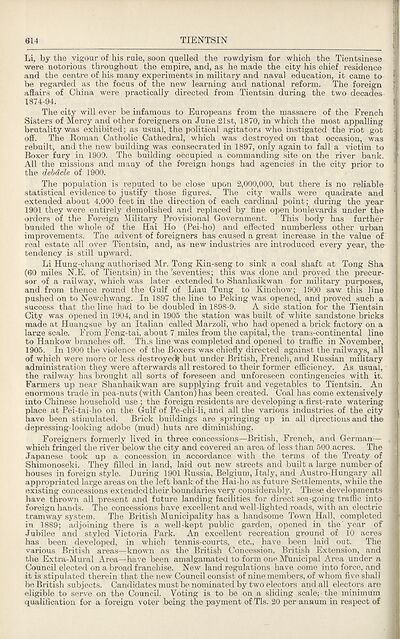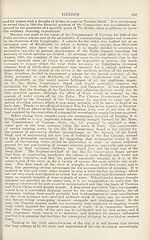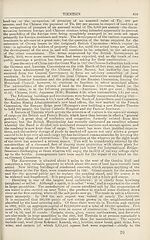1924
(684) Page 614
Download files
Complete book:
Individual page:
Thumbnail gallery: Grid view | List view

614
TIENTSIN
Li, by the vigour of his rule, soon quelled the rowdyism for which the Tientsinese
were notorious throughout the empire, and, as he made the city his chief residence
and the centre of his many experiments in military and naval education, it came to
be regarded as the focus of the new learning and national reform. The foreign
affairs of China were practically directed from Tientsin during the two decades
1874-94.
The city will ever be infamous to Europeans from the massacre of the French
Sisters of Mercy and other foreigners on June 21st, 1870, in which the most appalling
brutality was exhibited; as usual, the political agitators who instigated the riot got
off. The Roman Catholic Cathedral, which was destroyed on that occasion, was
rebuilt, and the new building was consecrated in 1897, only again to fall a victim to
Boxer fury in 1909. The building occupied a commanding site on the river bank.
All the missions and many of the foreign hongs had agencies in the city prior to
the debacle of 1900.
The population is reputed to be close upon 2,000,000, but there is no reliable
statistical evidence to justify those figures. The city 'walls were quadrate and
extended about 4,000 feet in the direction of each cardinal point; during the year
1901 they were entirely demolished and replaced by fine open boulevards under the
orders of the Foreign Military Provisional Government. This body has further
bunded the whole of the Eai Ho (Pei-ho) and effected numberless other urban
improvements. The advent of foreigners has caused a great increase in the value of
real estate all over Tientsin, and, as new industries are introduced every year, the
tendency is still upward.
Li Hung-chang authorised Mr. Tong Kin-seng to sink a coal shaft at Tong Sha
(60 miles N.E. of Tientsin) in the ’seventies; this was done and proved the precur¬
sor of a railway, which was later extended to Shanhaikwan for military purposes,
and from thence round the Gulf of Liau Tung to Kinchow; 1900 saw this line
pushed on to Newchwang. In 1897 the line to Peking was opened, and proved such a
success that the line had to be doubled in 1898-9. A side station for the Tientsin
City was opened in 1904, and in 1905 the station was built of white sandstone bricks
made at Huangsue by an Italian called Marzoli, who had opened a brick factory on a
large scale. From Feng-tai, about 7 miles from the capital, the trans-continental line
to Hankow branches off. Th,s line was completed and opened to traffic in November,
1905. In 1900 the violence of the Boxers was chiefly directed against the railways, all
of which were more or less destroyed^ but under British, French, and Russian military
administration they were afterwards all restored to their former efficiency. As usual,
the railway has brought all sorts of foreseen and unforeseen contingencies with it.
Farmers up near Shanhaikwan are supplying fruit and vegetables to Tientsin. An
enormous trade in pea-nuts (with Canton) has been created. Coal has come extensively
into Chinese household nse • the foreign residents are developing a first-rate watering
place at Pei-tai-ho on the Gulf of Pe-chi-li, and all the various industries of the city
have been stimulated. Brick buildings are springing up in all directions and the
depressing-looking adobe (mud) huts are diminishing.
Foreigners formerly lived in three concessions—British, French, and German—
which fringed the river below the city and covered an area of less than 500 acres. The
Japanese took up a concession in accordance with the terms of the Treaty of
Shimonoseki. They filled in land, laid out new streets and built a large number of
houses in foreign style. During 1901 Russia, Belgium, Italy, and Austro-Hungary all
appropriated large areas on the left bank of the Hai-ho as future Settlements, while the
existing concessions extended their boundaries very considerably. These developments
have thrown all present and future landing facilities for direct sea-going traffic into-
foreign hands. The concessions have excellent and well-lighted roads, with an electric
tramway system. The British Municipality has a handsome Town Hall, completed
in 1889; adjoining there is a well-kept public garden, opened in the' year of
Jubilee and styled Victoria Park. An excellent recreation ground of 10 acres
has been developed, in which tennis-courts, etc., have been laid out. The
various British areas—known as the British Concession, British Extension, and
the Extra-Mural Area—have been amalgamated to form one Municipal Area under a
Council elected on a broad franchise. New land regulations have come into force, and
it is stipulated therein that the new Council consist of nine members, of whom five shall
be British subjects. Candidates must be nominated by two electors and all electors are
eligible to serve on the Council. Voting is to be on a sliding scale; the minimum
qualification for a foreign voter being the payment of Tls. 20 per annum in respect of
TIENTSIN
Li, by the vigour of his rule, soon quelled the rowdyism for which the Tientsinese
were notorious throughout the empire, and, as he made the city his chief residence
and the centre of his many experiments in military and naval education, it came to
be regarded as the focus of the new learning and national reform. The foreign
affairs of China were practically directed from Tientsin during the two decades
1874-94.
The city will ever be infamous to Europeans from the massacre of the French
Sisters of Mercy and other foreigners on June 21st, 1870, in which the most appalling
brutality was exhibited; as usual, the political agitators who instigated the riot got
off. The Roman Catholic Cathedral, which was destroyed on that occasion, was
rebuilt, and the new building was consecrated in 1897, only again to fall a victim to
Boxer fury in 1909. The building occupied a commanding site on the river bank.
All the missions and many of the foreign hongs had agencies in the city prior to
the debacle of 1900.
The population is reputed to be close upon 2,000,000, but there is no reliable
statistical evidence to justify those figures. The city 'walls were quadrate and
extended about 4,000 feet in the direction of each cardinal point; during the year
1901 they were entirely demolished and replaced by fine open boulevards under the
orders of the Foreign Military Provisional Government. This body has further
bunded the whole of the Eai Ho (Pei-ho) and effected numberless other urban
improvements. The advent of foreigners has caused a great increase in the value of
real estate all over Tientsin, and, as new industries are introduced every year, the
tendency is still upward.
Li Hung-chang authorised Mr. Tong Kin-seng to sink a coal shaft at Tong Sha
(60 miles N.E. of Tientsin) in the ’seventies; this was done and proved the precur¬
sor of a railway, which was later extended to Shanhaikwan for military purposes,
and from thence round the Gulf of Liau Tung to Kinchow; 1900 saw this line
pushed on to Newchwang. In 1897 the line to Peking was opened, and proved such a
success that the line had to be doubled in 1898-9. A side station for the Tientsin
City was opened in 1904, and in 1905 the station was built of white sandstone bricks
made at Huangsue by an Italian called Marzoli, who had opened a brick factory on a
large scale. From Feng-tai, about 7 miles from the capital, the trans-continental line
to Hankow branches off. Th,s line was completed and opened to traffic in November,
1905. In 1900 the violence of the Boxers was chiefly directed against the railways, all
of which were more or less destroyed^ but under British, French, and Russian military
administration they were afterwards all restored to their former efficiency. As usual,
the railway has brought all sorts of foreseen and unforeseen contingencies with it.
Farmers up near Shanhaikwan are supplying fruit and vegetables to Tientsin. An
enormous trade in pea-nuts (with Canton) has been created. Coal has come extensively
into Chinese household nse • the foreign residents are developing a first-rate watering
place at Pei-tai-ho on the Gulf of Pe-chi-li, and all the various industries of the city
have been stimulated. Brick buildings are springing up in all directions and the
depressing-looking adobe (mud) huts are diminishing.
Foreigners formerly lived in three concessions—British, French, and German—
which fringed the river below the city and covered an area of less than 500 acres. The
Japanese took up a concession in accordance with the terms of the Treaty of
Shimonoseki. They filled in land, laid out new streets and built a large number of
houses in foreign style. During 1901 Russia, Belgium, Italy, and Austro-Hungary all
appropriated large areas on the left bank of the Hai-ho as future Settlements, while the
existing concessions extended their boundaries very considerably. These developments
have thrown all present and future landing facilities for direct sea-going traffic into-
foreign hands. The concessions have excellent and well-lighted roads, with an electric
tramway system. The British Municipality has a handsome Town Hall, completed
in 1889; adjoining there is a well-kept public garden, opened in the' year of
Jubilee and styled Victoria Park. An excellent recreation ground of 10 acres
has been developed, in which tennis-courts, etc., have been laid out. The
various British areas—known as the British Concession, British Extension, and
the Extra-Mural Area—have been amalgamated to form one Municipal Area under a
Council elected on a broad franchise. New land regulations have come into force, and
it is stipulated therein that the new Council consist of nine members, of whom five shall
be British subjects. Candidates must be nominated by two electors and all electors are
eligible to serve on the Council. Voting is to be on a sliding scale; the minimum
qualification for a foreign voter being the payment of Tls. 20 per annum in respect of
Set display mode to:
![]() Universal Viewer |
Universal Viewer | ![]() Mirador |
Large image | Transcription
Mirador |
Large image | Transcription
Images and transcriptions on this page, including medium image downloads, may be used under the Creative Commons Attribution 4.0 International Licence unless otherwise stated. ![]()
| Asian directories and chronicles > 1924 > (684) Page 614 |
|---|
| Permanent URL | https://digital.nls.uk/196432775 |
|---|
| Attribution and copyright: |
|
|---|---|
| Description | Volumes from the Asian 'Directory and Chronicle' series covering 1917-1941, but missing 1919 and 1923. Compiled annually from a multiplicity of local sources and research. They provide listings of each country's active corporations, foreign residents and government agencies of all nationalities for that year, together with their addresses. Content includes: various treaties; coverage of conflicts; currencies and taxes; consular fees; weights and measures; public holidays; festivals and traditions. A source of information for both Western states and communities of foreigners living in Asia. Published by Hongkong Daily Press. |
|---|---|
| Shelfmark | H3.86.1303 |
| Additional NLS resources: |

